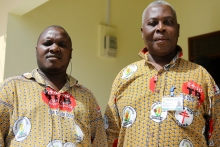Ghana: union involvement

Since the country was classified as one of the 15 countries with high risk of EVD infection, a National Preparedness and Response plan was developed around five thematic areas: Coordination, Surveillance, Case Management, Logistics and Finance/Security, and Social Mobilization & Risk Communication.
The plan includes the elaboration of a large coordination structure, the establishment of rapid response teams, communication lines from the community level to the national level, basic materials for rapid response, data collection forms, training on safety procedures for laboratories, Personal Protective Equipment for regional, teaching and some district hospitals, communication and campaigns in media and schools. The plan also provided incentives and support for health workers involved in Ebola in three areas: direct cash transfers, life insurance and treatment.
Despite the quite comprehensive plan, challenges remain in terms of incomplete treatment centres, insufficient training at the district level, inadequate simulation exercises, and the lack of earmarked funds for the EVD response. The rapid response teams might be trained, but not fully as a team with clear roles and responsibilities and an update of the National Preparedness and Response Plan is needed.
The Ghanaian Health Service Workers Union (HSWU) has followed the developments closely and made the additional demand for financial support for families of health workers who have died of Ebola. This support should consist not only of a lump sum but also of the payment of the deceased health workers’ monthly salary until this person would have achieved the age of 60, the compulsory retirement age in Ghana. HSWU has also introduced child survival benefits so that the education of deceased health workers is assured. This could be done by government scholarships and the establishment of a fund to support the child survival benefits
-
Read the publication on-line
-
Download a PDF of "PSI's Trade Union Response to the Ebola Virus Disease"
-
More on the PSI's Ebola response
-
Also see PSI's work on Health and Social care services
In this issue:
- Foreword: PSI Health Priorities and Trade Union Response to the Ebola Virus Disease
- A global view on the impact of Ebola
- Trade union response: the ebola response strategy
- Work on the ground: three national action plans
- The survey: mapping missing wages, hazard fees and family support
- Lobby: visits in the three most affected countries and the United States
- Liberia: trade union rights under attack
- Congo: unite the unions
- Ghana: unions involved

